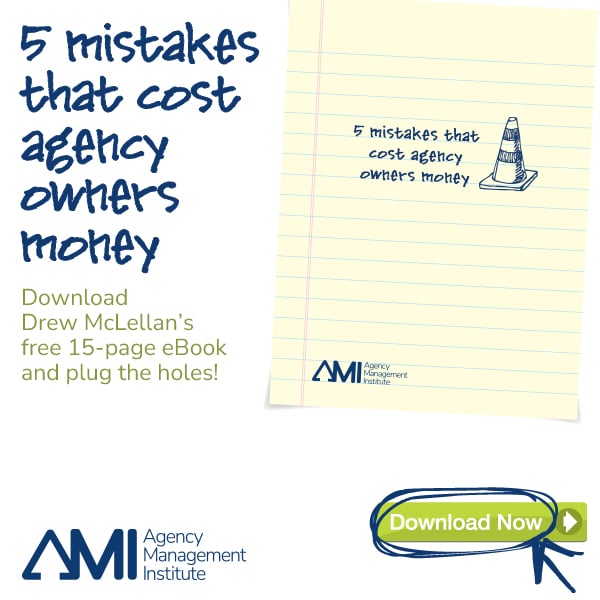New business, new business, new business. It’s something that I find myself talking to agency owners about every single day. Unfortunately most agencies are so busy retooling their business development program to chase new prospects that they forget their most important new business target – their current clients. 70% of your new revenue should be coming from your existing clients … 70%! What new business strategies do you have in place to make sure that happens?
New business opportunities aimed at new prospects always have to be a part of the plan but you also need to be courting your current roster of clients.
In this podcast, I give you a path to follow to address both your 70% and your 30%:
- Why about 70% of your new revenue should come from existing clients
- How to teach your AEs to grow the business that they’re serving
- The new business strategies for you, the business owner, to focus on new business
- The four areas of the sales funnel and how to work with all four
- The system for reaching out to your 25 best prospects
Drew McLellan is the Top Dog at Agency Management Institute. For the past 21 years, he has also owned and operated his own agency. Drew’s unique vantage point as being both an active agency owner and working with 250+ small- to mid-size agencies throughout the year, give him a unique perspective on running an agency today.
AMI works with agency owners by:
- Leading agency owner peer groups
- Offering workshops for owners and their leadership teams
- Offering AE bootcamps
- Conducting individual agency owner coaching
- Doing on-site consulting
- Offering online courses in agency new business and account service
Because he works with those 250+ agencies every year — he has the unique opportunity to see the patterns and the habits (both good and bad) that happen over and over again. He has also written two books and been featured in The New York Times, Entrepreneur Magazine, and Fortune Small Business. The Wall Street Journal called his blog “One of 10 blogs every entrepreneur should read.”
To listen – you can visit the Build A Better Agency site (https://www.agencymanagementinstitute.com/drew-mclellan-solocast-episode-10/) and grab either the iTunes or Stitcher files or just listen to it from the web.
If you’d rather just read the conversation, the transcript is below:
- Sustaining Your Business Using the 70 / 30 New Business Rule
- The New Business Strategies You Need to Hear
- The Four Most Vital Areas of the Sales Funnel
If you’re going to take the risk of running an agency, shouldn’t you get the benefits too? Welcome to Build a Better Agency where we show you how to build an agency that can scale and grow with better clients, invested employees and best of all, more money to the bottom line. Bringing his 25 plus years of expertise as both an agency owner and agency consultant to you, please welcome your host, Drew McLellan.
Drew: Hey, everybody. Drew McLellan here with another episode of Build a Better Agency. Today’s episode is one of my solocasts, so unlike the episodes you hear most often where I bring a guest in to chat with us about an area of expertise that they have that relates to making your agency bigger, better, stronger. Today like all my solocasts it’s just gonna be you and me. Just talking about something that I wanna make sure is on your radar screen. Something that I find myself talking to agency owners about over and over again so I know that it is important to you and your business. And today what I wanna to chat about is an aspect of new business that I think is super important for all of us to keep in mind.
Sustaining Your Business Using the 70 / 30 New Business Rule
So you know, for every agency owner if I said to them you know, what are the things that worry you the most? At the end of the day even if it’s your people that often give you a little angst, the reality is for most of you, the thing that worries you the most is sustaining the business and being able to grow your business. Being able to reward your good people. Being able to continue to add people to staff if that’s what your goal is and being able to obviously add to the bottom line. And all of that comes around to the business that comes in the door every day. So new business is one of those topics that if I am talking to an agency owner for an hour or five hours or I’m hanging out with a network, I promise you that is a topic that always comes up and is always of vital importance.
So I want to talk about a couple of things around your business. First of all, I think one of the things that many agency owners don’t really think about is the ratio of new revenue because really new business is really not about having more clients it’s about having more money. So new revenue and where that new revenue comes from. So the first thing I wanna sort of plant, the seed I want to plant in your head is that most of your new revenue for any given year should actually come from existing clients. I think we spend a ton of time chasing and courting after prospects and we forget that the most likely person to give us more money is someone who’s already given us money, and who we’ve already delighted and proven that we are a value.
And so about 70% of your new revenue should come from existing clients. So I’ll get to where the new, new revenue comes from in a second but what that means is if 70% of your revenue should come from existing clients, then the question I have for you is what are you doing to teach your AEs how to grow the business that they are serving? So part of it is about how do I grow it? How do I sell more things to my client? And that gets into am I thinking like a vendor or an order taker or am I really thinking like a business strategist and partner? Am I taking fresh ideas? And we dig into all of this in great detail in the AE boot camp. And one of the things that I tell the AEs that are there is it is your job to grow your book of business. And it’s reasonable for your boss to expect for you to grow the clients that you serve at least 10% a year.
Now let’s say an AE is handling three pieces of business. I’m not saying that every piece of business will grow magically by this same 10%, but I’m saying overall their entire book of business they should be able to grow that by 10% a year. And honestly, I think if you put a little bit of gasoline on the fire they should be able to grow it more than that because as they become more of a trusted adviser and as they continue to sit at the table and help clients strategize about business issues, problems, opportunities, there are going to be opportunities for your agency. And so the first rule of new business is what are you doing to get more business from the clients that you already have? How are you preparing your AEs to do that? How are you teaching them how to have business conversations?
And a lot of this quite honestly comes to some mentorship from you. You have to help them especially if you have young AEs. You have to help them be able to have the acumen to have those conversations and to recognize opportunities. And there are some things you can do to stimulate those opportunities as well, but at the end of the day it’s really about what you are measuring. So for all of your AEs, you should be giving them an idea of look, “Here is your book of business. Here is the AGI of the clients that you currently manage in January” say of 2017 or you should have done it in January of 2016. “Here is where I want it to be 12 months from now.” And obviously, you could have this conversation any time in the year.
“But now I’m gonna start meeting with you on a regular basis for us to put together a plan.” So again this is where the mentoring comes in. “A plan to help you grow those clients by that 10% at least.” So if you do that with all of your AEs, then you know, really for the most part you should be seeing a nice uptick in new revenue from existing clients. So that’s where 70% of your revenue comes in. The other 30% of new revenue needs to come from new opportunities with new clients. And that’s really when we talk about new business that seems to be where everyone focuses their attention. But when I sit down with agencies and we talk about their new business efforts, couple things, number one and this we can harken back to one of the very first solocasts I did.
The New Business Strategies You Need to Hear
The number one problem, and the number one reason why your new business program is faltering is because you, the owner, are not spending the time on it that you need to be. So you need to carve out time to spend on new business. And I know that you are in the weeds with your other employees. I know that you are serving clients. I know your clients are calling your directly. For the most part there may be a few of you that have avoided that trap, but you’ve got to find a way to step out of the business and focus on new business. And for most agency owners that’s tough, really tough. And so here are a couple quick strategies for doing that.
Number one, you need to have a new business team and it might be just you and one other person or it might be you and a couple other people. And you need to meet with them on a weekly basis. And you need to have a hit list and we’ll get into that in a minute, of prospects and you need to be reporting on activity. Why do you need to do that? As you have heard me say before, the coolest thing about being an agency owner is that you’re accountable to no one. But the most dangerous thing about being an agency owner, is that you are accountable to no one. So this weekly meeting where you and other people have to report in the activity, forces all of you to try and stay true to what you commit to in terms of new business.
The second thing I want you to do is I want you to look at your calendar. And I want you to identify at the very minimum a morning from 8:00 to noon or an afternoon from 1:00 to 5:00, but a morning would be much better or a whole day every week. And obviously you’ll have to schedule this out because you have some commitments on your calendar already where you cannot go into the office and that’s your new business time.
So you could be at home working on an RFP response. You could be scheduling coffees with prospects. You could be writing content, but you are doing something around new business. As you know from the earlier solocast if you listened, 50% of your time if you’re an agency owner should be spent on some new business activity between the weekly new business meeting and all the other things that we’re gonna talk about. I guarantee that most of you listening that that is not the case.
So right now let’s just try and carve out 20% of your day. So one day out of five I want you not to go into the office because you know once you go into the office, your day is shot. You’re lost. So I want you not to go into the office. And that’s when I want you to schedule new business appointments when you’re making prospecting calls, when you’re following up and whatever you’ve already done to try and generate interest or at least awareness of your agency. But I want you to schedule that time outside of the office so that it actually gets done. And I want you to block it on your calendar and I want it to be as sacred as anything else on your calendar so you can’t go, “Oh, well, that’s just my new business time. So yeah, go ahead and schedule the meeting.” You really need to hold that time sacred.
The Four Most Vital Areas of the Sales Funnel
So okay, 70% from existing clients, 30% from new clients. I want you to carve out some time so you have time to do it but then what do I do? What does this look like? When I go into agencies and I work with them, I’m building out their new business program. One of the things that I noticed is when we actually map out their sales funnel, that they are gaping holes in the sales funnel, and they don’t have a way to move someone from one phase of the sales funnel to another. And the way I explain this in very simple terms is I think there are three sort of main areas of your sales funnel before you get a client. And you actually have four areas of your sales funnel because one of your areas has to be existing clients. So the four areas are, and then I’ll dig into what each of them is, it’s the macro level, it’s the micro level, it’s the nano level and it’s the existing client level.
So let me tell you what each of those are, and what I think you should be doing in that space. So the macro level is the top of the funnel. These are people who’ve never heard of your agency, may not have any idea who you are, may not be looking for an agency. They’re just out there. And what you need to do is, and this is tied to I have to know, like and trust you before I can buy you. So think of this as the know or awareness phase. So the macro audience they don’t know who you are. They may not even know they have a need, but they’re out and about. And so your whole job in this phase of the sales funnel, your whole job is to get on their radar screen.
And this is where you all spend a lot of your time. So this is you’re writing an agency blog, you’re writing guest blog posts, your website content. Maybe you are writing a column for a trade show pub that is in one of your verticals. You are speaking at a conference. You are active on social, tweeting out content. You might be offering some free content that is going to show up well on search, and then you’re gonna try and trade that for an e-mail address. You might be doing some PPC or some other things, but this is basically where your thought leadership content lives. So this is you trying to establish a position of thought leadership around your verticals or something that makes your agency different than everyone else that might… This is also where you might put awards if you’ve won awards and you’re gonna get some publicity around that.
This is where your PR efforts would play into. So if you get interviewed by the Wall Street Journal about something, any of those sorts of things. Okay, so that’s all about the macro level.
The micro level is that’s when they have some awareness of you, either from your current new business strategies or whatever. So they know who you are. You are on their radar screen at least a little bit. You might have their e-mail address. You might have their name. They might have thrown their business card in a hat when you were speaking at a conference for a drawing. But you have some tangential connection to them but you don’t really have a relationship with them, right? So this is where you begin to build the relationship.
So this phase for me, the micro phase is both where you create credibility and connection. So here you might get someone to subscribe to your e-newsletter where you’re being helpful to them on an ongoing basis. You might hold an event. Your agency might hold an event in your market or tie it to a trade show or something else where you are offering your expertise and knowledge. This might be where somebody finds you through search, and they actually plug in their e-mail address and they ask you a question from the website. This might be also where people are making referrals for you. So now you’ve got the credibility of someone else saying that you’re good at what you do. So testimonials are another place where you build credibility in the micro phase. And this is also where you’re starting to create a little bit of relationship, a little bit of ongoing. So maybe they are starting to follow you on social.
Whatever that is, that’s the activity level that you need to be sort of now reaching out to them and as best you can, segmenting that list. So again, whether you are using marketing automation software or some sort of a drip campaign, this is where you are holding an apple out to them and you are saying, “Hey, go ahead and have a nibble and a little bit of a bite.” And then when they like that and maybe that’s a little bit of content, a little bit of free content or they’re starting to be a podcast listener, whatever that may be, now you’re offering them a bigger bite of the apple and so on. And you are trying to give them something that is valuable to them that gives them some sort of substance, makes them smarter so that they begin to know you, and now they begin to like you.
So this is the like phase, credibility phase, creating connection. I know who you are and now because you’re being helpful to me I am liking you. But really all of this is still pretty arm’s length. And the reality is for most of you, the sales cycle is pretty long. And so for some of you it might be a few months, and in many cases it might be years. Somebody might be on your e-newsletter list for three year, five years before they are either in a position or they have a need and they pick up the phone and call you. So this is really about nurturing the lead and getting permission to stay in front of them. So as long as you are helpful and useful to them, they will give you permission to stay in touch because you have no idea what day, what week, what month that all of a sudden this prospect who’s been on your list for a while is suddenly gonna have a need for an agency.
So you want to be present all the time so that on the day that they have the need, you get to at least have the opportunity to have the conversation. That’s what you are trying to do here is get opportunity to be invited to the table when they have something that they need help with. And you can’t do that if you’re not top of mind. So this is really about staying in touch, and beginning over time for them to build a relationship with you so that when they actually have a conversation with you or see you at the conference next to you or whatever that is, they feel like they know you, right? And they feel like they like you. They like your tone. They like how you talk, what you talk about and they like the fact that you’ve been helpful.
The most important part of the funnel though is what I call “the nano section.” So we’ve got the macro section, the micro section and the nano section. And the nano section is a list that I want you to build, and it should be no more than 25 prospects. And these prospects should absolutely fit your best client profile. And you should know exactly who your sweet-spot client is and who you can delight, who you can rocket out of the world for, who you can make great profit from. And the nano list should be packed with people like that.
These are companies, organizations that you know would be killer clients for you. And then what I want you to do is I want you to put together this list of 25. And I want you to have a very targeted system of reaching out to them every six to eight weeks. And it needs to be a mix of online and offline activities. So the cadence might look like you first send them a letter that gives them some sort of assessment about their website. Then maybe the next six to eight weeks you…so that’s gonna be either snail mail or you might send them an e-mail or a PDF.
Then the next thing you’re gonna do is you might send them a book that you think would be really relevant to their business and you’re gonna put a post-it note on a page or a chapter that you think they really need to read. And you’re gonna write a handwritten note to them saying, “Hey Drew, I think Chapter Two of this book is particularly pertinent to your industry given that this, this and this is happening. I would love to chat with you about it.” And you tuck in your business card.
So I want you to build out enough activity like that. So it might be a white paper. It might be an e-mail. It might be a phone call. It might be inviting them to an event. So let’s say you have a vertical in construction and you know they’re gonna be at the big trade show and you are gonna be there. Maybe you’re holding a pre-trade show cocktail party with one of the speakers or something. Maybe you’ve done research that you’re gonna be unveiling and you wanna give them a sneak peek.
But have about 24 different tactics, different touches that you can use with this nano list. And what that’ll give you is that gives you about three plus years of things that you can keep doing. Now, can you refine them? Yes. Can you change ’em out? Yes. What I don’t want you to do is put together the list, drop an email to them and then think, “Okay, in eight weeks I’ll figure out what I’m gonna do next” because you and I both know what’s gonna happen. You are gonna get busy because you’re not gonna do the…carve out the time like I told you to. And then it’s gonna be 6 weeks and then it’s gonna be 8 weeks and then it’s gonna be 12 weeks. And then you’re gonna go, “You know what, they probably have no idea who I am. Screw it! I’m not gonna do it at all.”
So I want you to have a plan where you’ve got this mapped out, and you begin to work that list. And here’s the deal with that list. You work that list and you keep following up and you keep mailing them things and e-mailing them things and you know, carrier pigeoning them things. Whatever you’re doing you need to keep doing that until one of two things happens. Either they hire you or they get a restraining order and tell you to go away. Okay, maybe not the restraining order, but they tell you to go away. Otherwise you keep working that list because the reality is if you’ve built that list well, if you can have some way of making sure that you are constantly talking to them. And if you can land one or two because you’ve really done your due diligence and built out that list brilliantly so it really matches with your sweet-spot clients. If you land one or two of those a year, you’re gonna have a great year because remember you’ve only got to make up 30% of your new business income, of your new income, new revenue from new clients.
So if you keep working that list, I promise you one or two of those 25 is gonna turn every year. So what happens is say number seven hires you. Great. You fill in number seven slot with another prospect. So you keep working that list of 25. Why 25? Because 15 is too few and 30 is too many. You won’t be able to manage it. So you set the numbers. So anywhere between you know 20-25, somewhere around there that you can constantly be touching on a regular basis with these tactics like I talked about. And again, you’re gonna do it for the duration. So until they hire you or they tell you to go away, if you mind those three sales funnels, you’re gonna drop a lot of clients to the bottom line and…a lot of prospects into clients to the bottom line.
Then what happens is the fourth part of the funnel. And this is the part that most agencies absolutely forget about when developing new business strategies, and that’s the clients because remember they’re the guys that you need to get 70% of your new revenue from. So you need to have a new business program and plan aimed at your clients. And you need to do some client-only things that make them feel special and valued. And again whatever that might be you might have a client-only event. You might bring in a speaker. You might do some special things for them in terms of planning. You can figure that part out. The important thing is at least for this podcast I want you to think about is do I have a new business road-map of tactics mapped out for the macro, micro, nano levels of my sales funnel and what am I doing for my existing clients?
So am I making sure that people know who I am? Am I making sure that they like the agency because we are being helpful and useful and demonstrating our knowledge, and am I doing that consistently enough that they trust me so that they will give me their business? And once they do that what am I doing to retain that business? So if you can put together your new business thinking around those concepts, I think 2017 is gonna be an awesome year for you.
And with that I think that’s plenty for you to think about for one podcast. So I am gonna step away. I hope you have a great week. I hope that you are able to implement some of these ideas. And I hope you come back next week.
Next week I will have another guest who will share their expertise. If you need me in the meantime, you know you can find me at [email protected]. You can also go to agencymanagementinstitute.com to find out more about our workshops and our coaching and all the other things that we do to help agencies. And I hope that this has been helpful, and I hope it helps you make a bigger, better, stronger agency for you, your family, your employees. I’ll talk to you soon.
That’s all for this episode of Build a Better Agency on new business strategies and the four areas of the sales funnel. Be sure to visit agencymanagementinstitute.com to learn more about our workshops and other ways we serve small to mid-sized agencies. While you’re there, sign up for our e-newsletter, grab our free e-book and check out the blog. Growing a bigger or better agency that makes more money, attracts bigger clients and doesn’t consume your life is possible here on Build a Better Agency.






